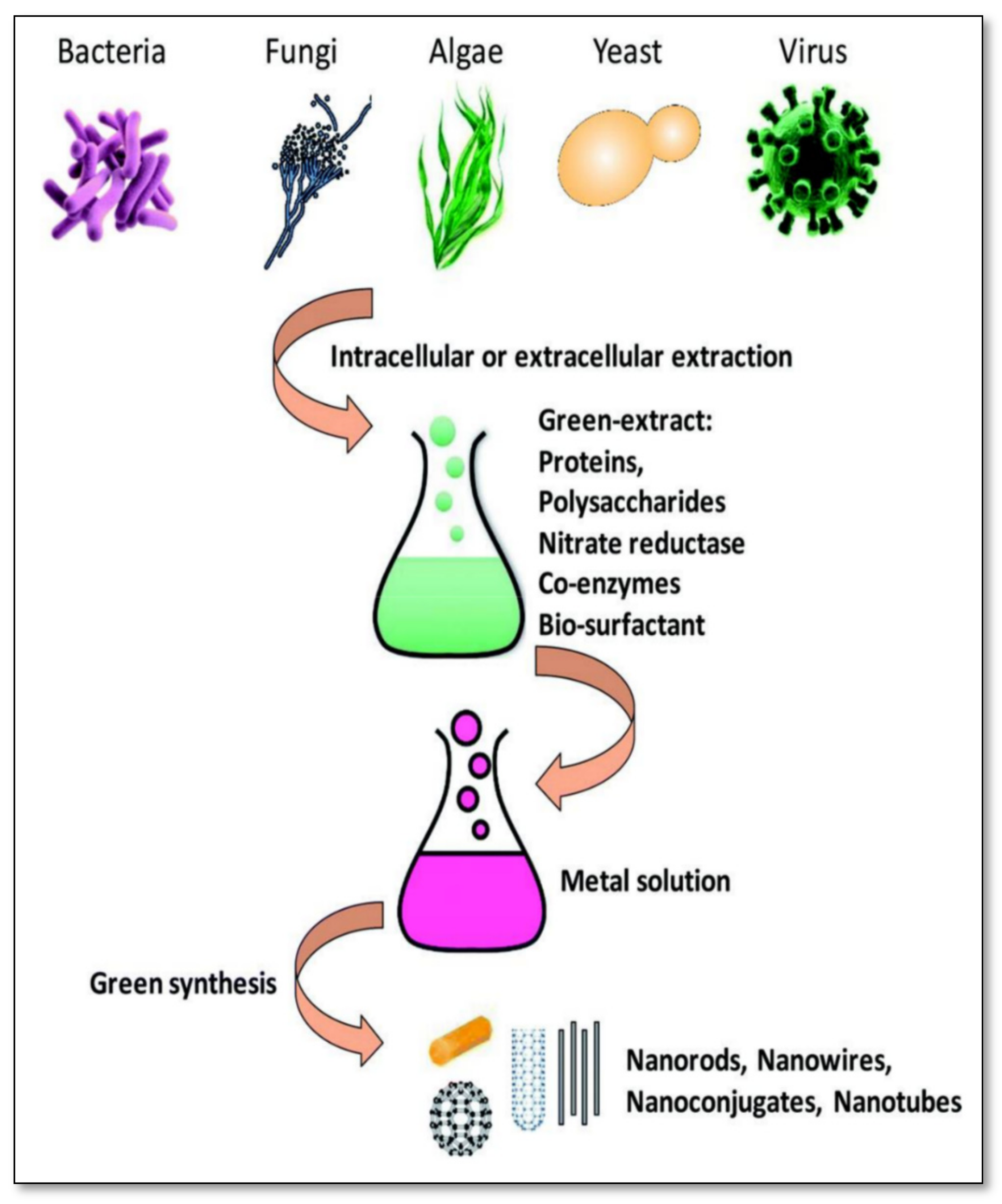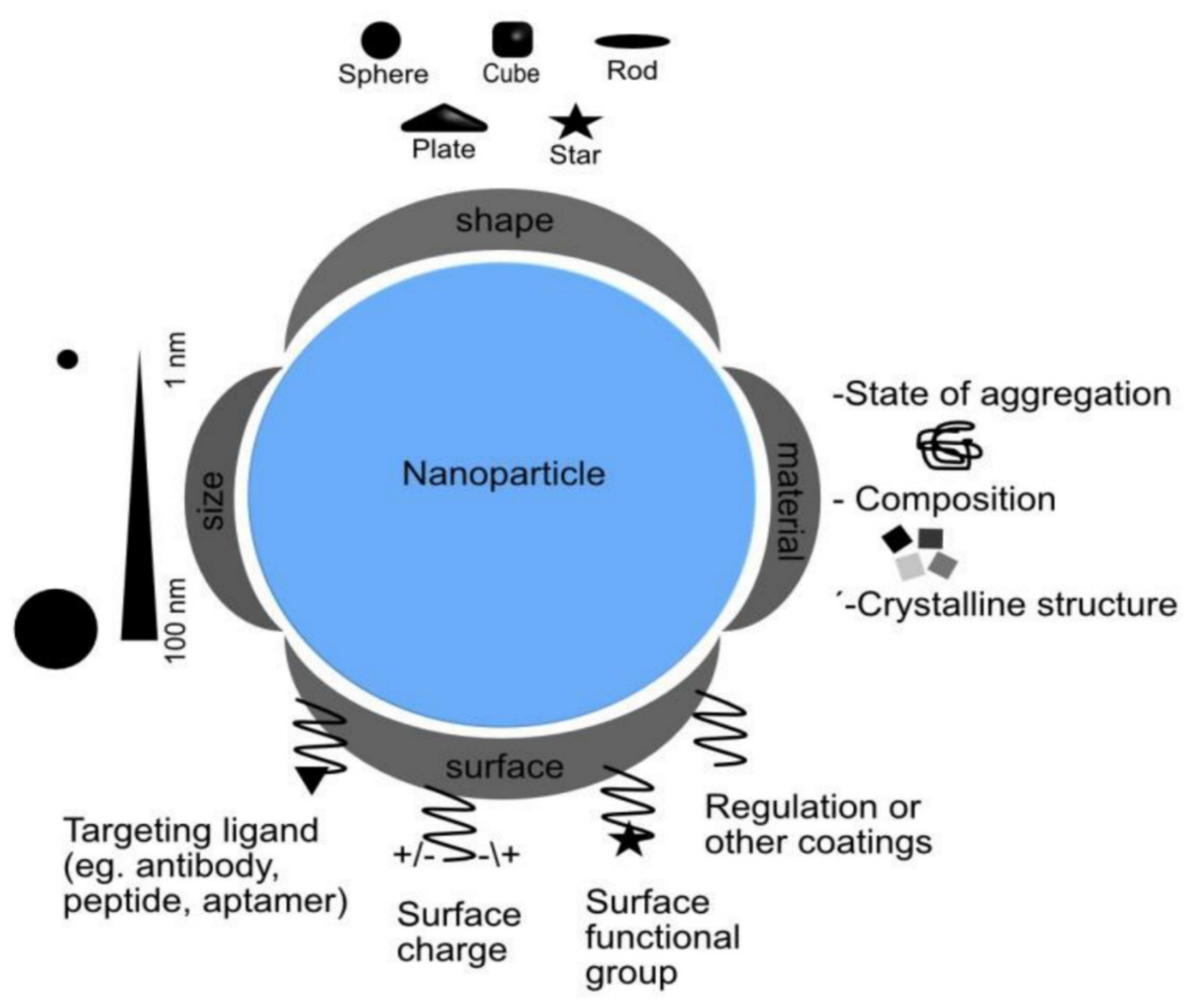Many well-established methods are extensively utilized for the synthesis of nanocatalysts. However, most conventional physical and chemical methods have some drawbacks, such as the toxicity of precursor materials, the requirement of high-temperature environments, and the high cost of synthesis, which ultimately hinder their fruitful applications in various fields. Bioinspired synthesis is eco-friendly, cost-effective, and requires a low energy/temperature ambient. Various microorganisms such as bacteria, fungi, and algae are used as nano-factories and can provide a novel method for the synthesis of different types of nanocatalysts. The synthesized nanocatalysts can be further utilized in various applications such as the removal of heavy metals, treatment of industrial effluents, fabrication of materials with unique properties, biomedical, and biosensors.
- green source
- nanocatalysts
- nanoparticles
- bacteria
- fungi
- algae
1. Introduction
2. Biological Approach for Nanocatalyst/Nanoparticle Synthesis
The biological method is preferred over the other two conventional methods (top-down and bottom-up) as it is a green method, environmentally friendly, and does not require a higher energy consumption [22][18]. Nanoparticles obtained through the biological approach have a greater specific surface area, increase the rate of catalysis, and have metal salt and improved enzymes [23][19]. Hence, the main objective in the synthesis of nanoparticles using a biological approach is to utilize cheap resources and facilitate a continuous production of nanoparticles. Biological sources that are used for nanoparticle synthesis provide a simple method and easy increase in biomass, ensuring a uniform particle size, as well as multiplication. The use of microbes is one of the most prominent methods among the biological approaches of nanoparticle synthesis. It utilizes different biological sources such as bacteria, fungi, and algae (Figure 21). Bacteria are the most commonly found organism in our biosphere. Under optimal conditions such as pH, temperature, and pressure, bacteria show the capability to synthesize various nanoparticles [24][20] (Figure 32). The ability of bacterial cells to survive and proliferate under extreme climatic conditions make them the most ideal organisms for nanoparticle synthesis. They can reproduce and multiply even under high metal concentrations, which may be due to particular resistance mechanisms. Strains of bacteria that are not resistant to high metal concentrations can also be employed as appropriate microbes. The nanoparticles produced by microorganisms have important uses in the biological field such as bioleaching, biocorrosion, biomineralization, and bioremediation. In addition to bacteria, fungi and algae are two other green sources that are capable of synthesizing nanoparticles. Fungi have an outstanding ability for the synthesis of various bioactive compounds that have potential for numerous applications. They are widely used as reducing and stabilizing agents and can be easily grown on a large scale for the production of nanoparticles with controlled shape and size [25][21]. Similarly, algae have the ability to synthesize various bioactive compounds, pigments, and proteins, which help in the reduction of salts and act as capping agents in the synthesis mechanism [26][22].
3. Conclusions
References
- Roy, A.; Bharadvaja, N. Silver nanoparticle synthesis from Plumbago zeylanica and its dye degradation activity. Bioinspired Biomim. Nanobiomaterials 2019, 8, 130–140.
- Ahmed, H.M.; Roy, A.; Wahab, M.; Ahmed, M.; Othman-Qadir, G.; Elesawy, B.H.; Khandaker, M.U.; Islam, M.N.; Emran, T.B. Applications of Nanomaterials in Agrifood and Pharmaceutical Industry. J. Nanomater. 2021, 2021, 1472096.
- Roy, A. Plant Derived Silver Nanoparticles and their Therapeutic Applications. Curr. Pharm. Biotechnol. 2021, 22, 1834–1847.
- Thakkar, K.N.; Mhatre, S.S.; Parikh, R.Y. Biological synthesis of metallic nanoparticles. Nanomed. Nanotechnol. Biol. Med. 2010, 6, 257–262.
- Jeevanandam, J.; Barhoum, A.; Chan, Y.S.; Dufresne, A.; Danquah, M.K. Review on nanoparticles and nanostructured materials: History, sources, toxicity and regulations. Beilstein J. Nanotechnol. 2018, 9, 1050–1074.
- Remya, V.R.; Abitha, V.K.; Rajput, P.S.; Rane, A.V.; Dutta, A. Silver nanoparticles green synthesis: A mini review. Chem. Int. 2017, 3, 165–171.
- Iravani, S.; Korbekandi, H.; Mirmohammadi, S.V.; Zolfaghari, B. Synthesis of silver nanoparticles: Chemical, physical and biological methods. Res. Pharm. Sci. 2014, 9, 385.
- Raina, S.; Roy, A.; Bharadvaja, N. Degradation of dyes using biologically synthesized silver and copper nanoparticles. Environ. Nanotechnol. Monit. Manag. 2020, 13, 100278.
- Nagore, P.; Ghotekar, S.; Mane, K.; Ghoti, A.; Bilal, M.; Roy, A. Structural Properties and Antimicrobial Activities of Polyalthia longifolia Leaf Extract-Mediated CuO Nanoparticles. BioNanoScience 2021, 11, 579–589.
- Shah, M.; Fawcett, D.; Sharma, S.; Tripathy, S.K.; Poinern, G.E.J. Green synthesis of metallic nanoparticles via biological entities. Materials 2015, 8, 7278–7308.
- Loomba, L.; Scarabelli, T. Metallic nanoparticles and their medicinal potential. Part II: Aluminosilicates, nanobiomagnets, quantum dots and cochleates. Ther. Deliv. 2013, 4, 1179–1196.
- Tajzad, I.; Ghasali, E. Production methods of CNT-reinforced Al matrix composites: A review. J. Compos. Compd. 2020, 2, 1–9.
- Puente Santiago, A.R.; Fernandez-Delgado, O.; Gomez, A.; Ahsan, M.A.; Echegoyen, L. Fullerenes as Key Components for Low-Dimensional (Photo) Electrocatalytic Nanohybrid Materials. Angew. Chem. 2021, 133, 124–143.
- C Thomas, S.; Kumar Mishra, P.; Talegaonkar, S. Ceramic nanoparticles: Fabrication methods and applications in drug delivery. Curr. Pharm. Des. 2015, 21, 6165–6188.
- Chaudhary, R.G.; Bhusari, G.S.; Tiple, A.D.; Rai, A.R.; Somkuvar, S.R.; Potbhare, A.K.; Abdala, A.A. Metal/metal oxide nanoparticles: Toxicity, applications, and future prospects. Curr. Pharm. Des. 2019, 25, 4013–4029.
- Suresh, S. Semiconductor nanomaterials, methods and applications: A review. Nanosci. Nanotechnol. 2013, 3, 62–74.
- Crucho, C.I.; Barros, M.T. Polymeric nanoparticles: A study on the preparation variables and characterization methods. Mater. Sci. Eng. C 2017, 80, 771–784.
- Roy, A.; Bharadvaja, N. Silver nanoparticles synthesis from a pharmaceutically important medicinal plant Plumbago zeylanica. MOJ Bioequivalence Bioavailab. 2017, 3, 00046.
- Liang, X.J.; Kumar, A.; Shi, D.; Cui, D. Nanostructures for medicine and pharmaceuticals. J. Nanomater. 2012, 2012, 921897.
- Auría-Soro, C.; Nesma, T.; Juanes-Velasco, P.; Landeira-Viñuela, A.; Fidalgo-Gomez, H.; Acebes-Fernandez, V.; Gongora, R.; Almendral Parra, M.J.; Manzano-Roman, R.; Fuentes, M. Interactions of nanoparticles and biosystems: Microenvironment of nanoparticles and biomolecules in nanomedicine. Nanomaterials 2019, 9, 1365.
- Guilger-Casagrande, M.; de Lima, R. Synthesis of Silver Nanoparticles Mediated by Fungi: A Review. Front. Bioeng. Biotechnol. 2019, 7, 287.
- Huynh, K.H.; Pham, X.H.; Kim, J.; Lee, S.H.; Chang, H.; Rho, W.Y.; Jun, B.H. Synthesis, properties, and biological applications of metallic alloy nanoparticles. Int. J. Mol. Sci. 2020, 21, 5174.

